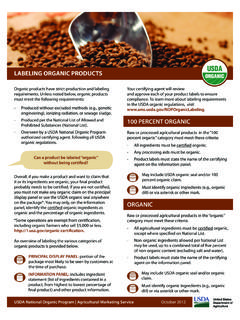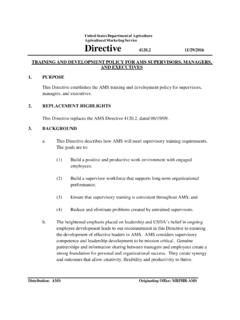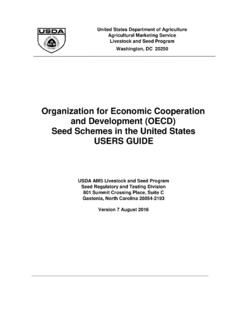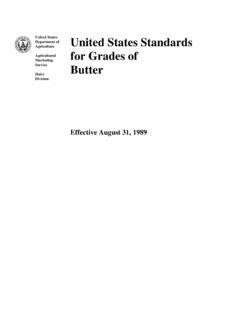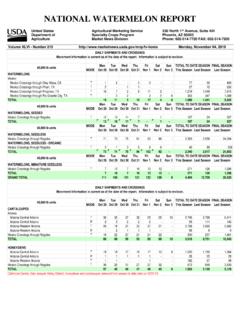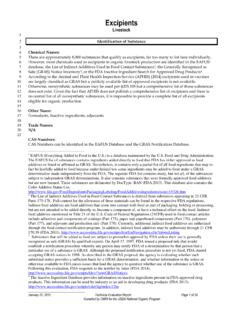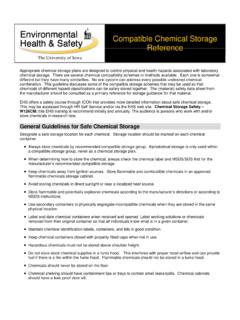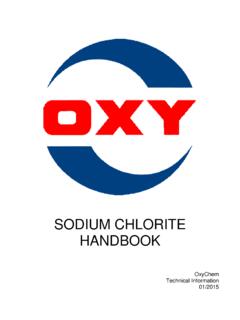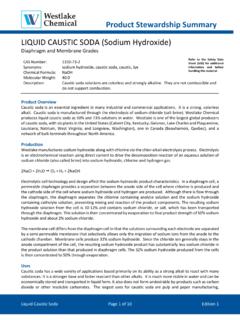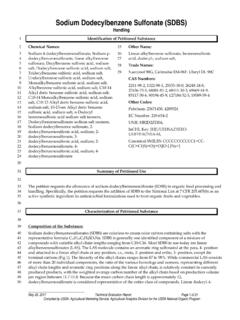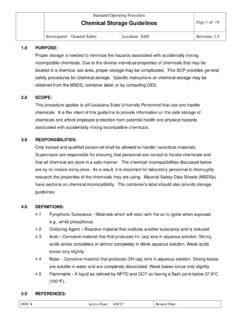Transcription of Hypochlorous Acid
1 Hypochlorous Acid Handling _____ August 13, 2015 Technical Evaluation Report Page 1 of 24 Compiled by USDA, Agricultural Marketing Service, Agricultural Analytics Division for the USDA National Organic Program Identification of Petitioned Substance 1 Chemical Names: Hypochlorous acid, 2 hypochloric(I) acid, chloranol, 3 hydroxidochlorine 4 Other Name: Hydrogen hypochlorite, 5 Chlorine hydroxide 6 Trade Names: Bleach, sodium hypochlorite, 7 Calcium hypochlorite, Sterilox, hypochlorite, 8 NVC-10 9 CAS Numbers: 7790-92-3 Other Codes: European Community 10 Number-22757, IUPAC- Hypochlorous acid 11 List other codes: PubChem CID 24341 InChI Key: QWPPOHNGKGFGJK-UHFFFAOYSA-N UNII: 712K4 CDC10 Summary of Petitioned Use 12 A petition has been received from a stakeholder requesting that Hypochlorous acid (also referred 13 to as electrolyzed water (EW)) be added to the list of synthetic substances allowed for use in 14 organic production and handling (7 CFR ).
2 Specifically, the petition concerns the 15 formation of Hypochlorous acid at the anode of an electrolysis apparatus designed for its 16 production from a brine solution. This active ingredient is aqueous Hypochlorous acid which acts 17 as an oxidizing agent. The petitioner plans use Hypochlorous acid as a sanitizer and antimicrobial 18 agent for the production and handling of organic products. The petition also requests to resolve a 19 difference in interpretation of allowed substances for chlorine materials on the National List of 20 Allowed and Prohibited Substances that contain the active ingredient Hypochlorous acid (NOP-21 PM 14-3 Electrolyzed water). 22 The NOP has issued NOP 5026 Guidance, the use of Chlorine Materials in Organic Production 23 and Handling.
3 This guidance document clarifies the use of chlorine materials in organic 24 production and handling to align the National List with the November, 1995 NOSB 25 recommendation on chlorine materials which read: 26 Allowed for disinfecting and sanitizing food contact surfaces. Residual 27 chlorine levels for wash water in direct crop or food contact and in flush water 28 from cleaning irrigation systems that is applied to crops or fields cannot exceed 29 the maximum residual disinfectant limit under the Safe Drinking Water Act 30 (currently 4 ppm expressed as Cl2). 31 The recent policy memo, NOP PM-14-3, clarifies which synthetic chlorine compounds specified in 32 the National List are allowed for use in organic production and handling. Although Hypochlorous 33 acid is an intermediate product produced when hypochlorite salts or chlorine are dissolved in 34 water, purified or generated Hypochlorous acid is not specifically included on the National List.
4 35 Characterization of Petitioned Substance 36 Composition of the Substance: 37 Hypochlorous acid (also referred to as electrolyzed water, EW) is an oxyacid of chlorine (with formula 38 HClO) containing monovalent chlorine that acts as an oxidizing or reducing agent (NCBI, 2015; Su et 39 al., 2007). It is a weak acid and highly unstable and can only exist in solution. The molecules are 40 electron accepting in oxidation-reduction reactions in which electrons are transferred from one 41 molecule to another (NCBI, 2015). 42 Technical Evaluation Report Hypochlorous Acid Handling August 13, 2015 Page 2 of 24 Electrolyzed water ("electrolyzed water , EOW, ECA, electrolyzed oxidizing water, electro-activated 43 water or electro-chemically activated water solution) is produced by the electrolysis of water- sodium 44 chloride solution.
5 The electrolysis of such salt solutions produces Hypochlorous acid, hypochlorite, and 45 free chlorine. 46 Source or Origin of the Substance: 47 As reported by Hricova et al., 2008 and Huang et al., 2009, EW is the product of the electrolysis of 48 a dilute NaCl solution in an electrolysis cell, containing a semi-permeable membrane that 49 physically separates the anode and cathode but permitting specific ions to pass through. The 50 basic approach for producing EW is shown in Figure 1. The voltage between the electrodes is 51 generally set at 9 to 10 volts (Al-Haq et al., 2005). During electrolysis, sodium chloride (NaCl) 52 dissolved in deionized water (brine) dissociates into negatively charged chloride (Cl ) and 53 positively charged sodium (Na+).
6 At the same time, hydroxide (OH ) and hydrogen (H+) ions 54 are formed. Negatively charged ions Cl and OH move to the anode to lose electrons and form 55 oxygen gas (O2), chlorine gas (Cl2), hypochlorite ion (OCl ), Hypochlorous acid (HOCl) and 56 hydrochloric acid. 57 Fig. 1 Schematic of Hypochlorous acid generator action 58 59 (from Huang et al., 2009) 60 Positively charged ions such as H+ and Na+ move to the cathode to form hydrogen gas (H2) and 61 sodium hydroxide (NaOH). The solution separates into an acidic solution on the anode side of 62 the membrane, with a pH of 2 to , an oxidation-reduction potential (ORP) of 1,000 mV, and a 63 chlorine content of 10 to 90 ppm, and a basic solution on the cathode side of the membrane, with 64 a pH of to 13 and an ORP of ~-800 to -900 mV.
7 The solution from the anode is called acidic 65 electrolyzed water (EW), and the cathodic solution is known as basic EW. Neutral EW, with a 66 pH of 6 to and an ORP of 750 mV, is produced by mixing the anodic solution with OH ions 67 or by using a single-cell chamber. 68 Basic chemical reactions at the anode (positive pole) and at the cathode (negative pole) are 69 provided in Table 1. The solution from the anode is called acidic electrolyzed water, acid 70 oxidizing water, or electrolyzed oxidizing water, and the cathodic solution is known as basic 71 electrolyzed water, alkaline electrolyzed water, or electrolyzed reducing water. As reported by 72 Al-Haq et al., 2005, there are a number of EW-producing instruments available in the 73 marketplace.
8 They can be divided into those that contain a membrane and produce acidic EW 74 Technical Evaluation Report Hypochlorous Acid Handling August 13, 2015 Page 3 of 24 and basic EW (two-cell chamber) and those that do not contain a membrane and therefore 75 produce neutral EW (single-cell chamber). 76 Table 1 Formula Representation of Hypochlorous Acid Production* Anode (positive pole): 2H2O 4H++O2 +4e- 2 NaCl Cl2 + 2e-+2Na+ Cl+H2O HCl+HOCl Cathode (negative pole): 2H2O+ 2e- 2OH-+H2 2 NaCl +2OH- 2 NaOH+Cl- *H-hydrogen, O-oxygen, Na- sodium , Cl-chlorine, e-transfer electron Properties of the Substance: 77 The physical properties and chemical composition (Table 2) of Hypochlorous acid (EW) will vary 78 depending on the concentration of NaCl solution, amperage level, time of electrolysis, 79 temperature and pH (Wiant, C.)
9 , 2013, Eryilmaz et al., 2013, Al-Haq et al., 2005). These properties 80 impact the antimicrobial/sanitizing effects of Hypochlorous acid (EW). Sanitizing means 81 reducing the microorganisms of public health importance to levels considered safe, without 82 adversely affecting either the quality of the product or its safety (Pfuntner, 2011). 83 Table 2. Chemical and Physical Properties of Hypochlorous acid (NCBI, 2015) Chemical formula HOCl Molar mass g/mol Appearance colorless aqueous solution Solubility in water soluble Number of H+ bond acceptors 1 Number of H+ bond donors 1 Density g/cm3 Dissociation constant (pKa) The effectiveness of Hypochlorous acid as an active sanitizing agent is determined in large part by 84 the pH, a measure of the acidity or hydrogen ion concentration of the solution.
10 Hypochlorous 85 acid exists interchangeably with other chlorine species, including chlorine, hydrogen chloride 86 (aqueous and gaseous) and hypochlorite. This is supported by the equilibrium chemistry of 87 active chlorine. In a controlled pH environment, Hypochlorous acid will exist as the dominant 88 chlorine species under pH conditions ranging from 2 to (Figure 2). 89 90 Technical Evaluation Report Hypochlorous Acid Handling August 13, 2015 Page 4 of 24 Specific Uses of the Substance: 91 Electrolyzed water (EW) is produced by electrolysis of a dilute water- sodium chloride solution 92 flowing through specialized equipment designed to separate alkaline and acidic products (Fig. 1). 93 This electrolytic process facilitates the conversion of chloride ions and water molecules into 94 chlorine oxidants (chlorine gas, Hypochlorous acid, and hypochlorite ion) within the anode 95 chamber and sodium hydroxide in the cathode chamber of the production equipment.


